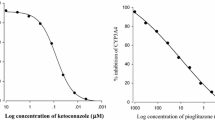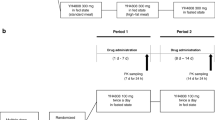Abstract
The elimination of [3H]pafenolol and metabolites was investigated in fasted and fed rats. Separate groups received intravenous doses (0.3 and 3.0 µmol/kg) and oral doses (1 and 25 µmol/kg). After iv administration of pafenolol, the excretion of unchanged drug into urine and feces was about 50 and 25–30% of the given dose, respectively. The predominating mechanism for the excretion of pafenolol into feces was intestinal excretion (exsorption) directly from blood into gut lumen, since only about 3% of a given iv dose was recovered as pafenolol in the bile. When the oral dose was raised from 1 to 25 µmol/kg, the mean (±SD) bioavailability, calculated from urine data, increased from 14 ± 9 to 30 ± 11% (P < 0.05) in the starved rats and from 14 ± 3 to 16 ± 3% in the fed animals. In parallel, the fraction absorbed from the gut (f a) increased from 19 ± 9 to 31 ± 10% in the starved rats and from 16 ± 4 to 19 ± 5% in the fed animals, respectively. This indicates that the low bioavailability is due primarily to poor intestinal uptake.
Similar content being viewed by others
REFERENCES
J.-A. Björkman, L. Ek, E. Carlsson, and B. Lundgren. Pafenolol II. Cardiovascular effects in anaesthetized dogs. Abstract, XVII Joint Meeting of the Scandinavian Physiological and Pharmacological Society, Reykjavik, August 1982. Acta Physiol. Scand. Suppl. 508:42 (1982).
B. Lundgren, E. Carlsson, and L. Ek. β-Blocking potency and selectivity in in vivo and in vitro experiments. Abstract, XVII Joint Meeting of the Scandinavian Physiological and Pharmacological Society, Reykjavik, August 1982. Acta Physiol. Scand. Suppl. 508:44 (1982).
C. G. Regårdh, A. Heggelund, K. Kylberg-Hansen, and P. Lundborg. Pharmacokinetics of pafenolol after iv and oral administration of three separate doses of different strength to man. Biopharm. Drug Dispos. 11:607–618 (1990).
C. G., Regårdh, P. Lundborg, M. Gabrielsson, A. Heggelund, and K. Kylberg-Hansen. Pharmacokinetics of a single intravenous and oral dose of pafenolol—a beta1-adrenoceptor antagonist with atypical absorption and disposition properties in man. Pharm. Res. 7:1222–1227 (1990).
A. Heggelund, C. Jansson, P. Lundborg, and C. G. Regårdh. The effect of food on the gastrointestinal absorption of pafenolol—a preliminary study. Hässle Report No. 206-778:1–10 (1982).
S. S. Davis, J. G. Hardy, and J. W. Fara. Transit of pharmaceutical dosage forms through the small intestine. Gut 27:886–892 (1986).
H. Lennernäs and C. G. Regårdh. Pharmacokinetics of pafenolol in the rat: A suitable model for studying absorption mechanisms of a drug exhibiting unusual absorption properties in man. Biopharm. Drug Disposit. 11:619–631 (1990).
Statistical Consultants, Inc. PCNONLIN and NONLIN: Software for the statistical analysis of nonlinear models. Am. Stat. 40:52 (1986).
C. D. Klaassen. Bile flow and composition during bile acid depletion and administration. Can. J. Physiol. Pharmacol. 52:334–348 (1974).
Ö. Källskog, H. R. Ulfendahl, and M. Wolgast. Single glomerular blood flow as measured with carbonized 141-Ce labelled microspheres. Acta Physiol. Scand. 85:408–413 (1972).
Ö. Källskog, L. O. Lindbom, H. R. Ulfendahl, and M. Wolgast. Kinetics of the glomerular ultrafiltration in the rat kidney. An experimental study. Acta Physiol. Scand. 95:293–300 (1975).
K. Turnheim and F. Lauterbach. Absorption and secretion of monoquarternary ammonium compounds by the isolated mucosa. Biochem. Pharmacol. 26:99–108 (1977).
F. Lauterbach. Absorption of cardiac glycosides. Acta Pharmacol. (Kbh.) 29:80 (1971).
R. B. Sund and F. Lauterbach. Intestinal secretion of sulphanilic acid by the isolated mucosa of guinea pig jejunum. Acta Pharmacol. Toxicol. 43:331–338 (1978).
C. F. George and B. S. Gruchy. Elimination of drugs by active intestinal transport. J Pharm. Pharmacol. 31:643–644 (1979).
K. Arimori and M. Nakano. Transport of procainamide and N-acetylprocainamide from blood into the intestinal lumen and intestinal dialysis by oral activated charcoal in rats with acute renal failure. J. Pharmacobio. Dyn. 11:504–511 (1988).
K. Arimori and M. Nakano. Dose-dependency in the exsorption of theophylline and the intestinal dialysis of theophylline by oral activated charcoal in rats. J. Pharm. Pharmacol. 40:101–107 (1988).
K. Turnheim and F. Lauterbach. Interaction between intestinal absorption and secretion of monoquarternary ammonium compounds in guinea pigs—a concept for the absorption kinetics of organic cations. J. Pharmacol. Exp. Ther. 212:418–424 (1980).
Author information
Authors and Affiliations
Rights and permissions
About this article
Cite this article
Lennernäs, H., Regårdh, CG. Dose-Dependent Intestinal Absorption and Significant Intestinal Excretion (Exsorption) of the β-Blocker Pafenolol in the Rat. Pharm Res 10, 727–731 (1993). https://doi.org/10.1023/A:1018916017723
Issue Date:
DOI: https://doi.org/10.1023/A:1018916017723




